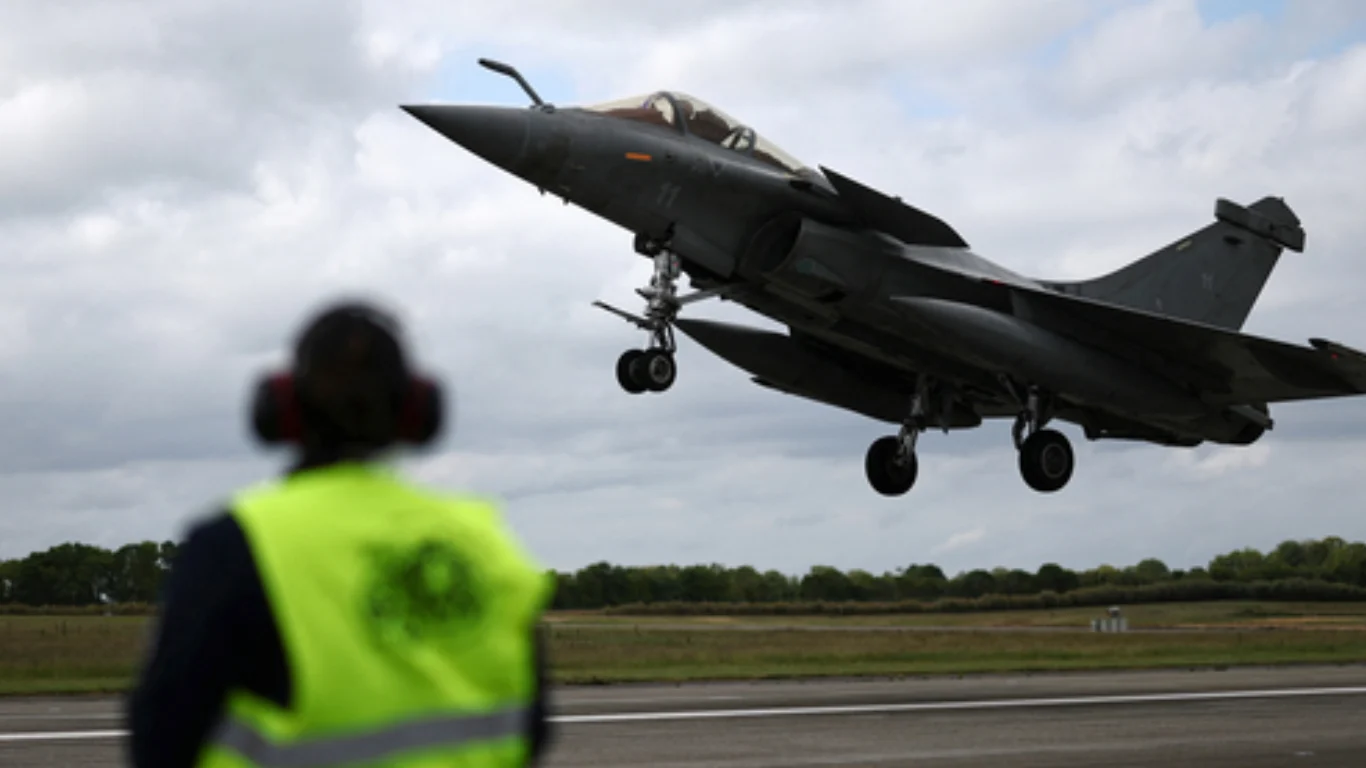
In a week dominated by geopolitical tensions and military maneuvers in South Asia, the global defense market has seen dramatic shifts — with shares of French defense manufacturer Dassault Aviation tumbling and China’s Chengdu Aircraft Corporation (CAC) soaring on rising demand and investor optimism. The divergence in stock performance highlights how conflict, strategic procurement, and market sentiment intersect in the high-stakes aerospace and defense sector.
Dassault Stock Declines Despite Strong Fundamentals
Dassault Aviation, the maker of the Rafale fighter jet — a mainstay of the Indian Air Force’s current fleet — suffered a sharp drop in the European stock market, falling over 7% intraday on Monday. The stock hit a low of EUR 292, down from EUR 325.8 just days earlier. This comes despite the company’s strong financials and a recent surge in interest following India’s precision strike against terrorist infrastructure in Pakistan during the recently conducted “Operation Sindoor.”
According to Live Mint, Dassault shares had surged following the May 7 air operation, which was widely reported to have involved Rafale jets equipped with SCALP cruise missiles and HAMMER precision-guided munitions. Notably, these strikes were carried out with careful precision, avoiding direct violations of Pakistani airspace — a testament to the long-range and high-tech capabilities of the French fighter jets.
Volatility and Speculation Drive Down Dassault
Market analysts attribute the recent downturn in Dassault Aviation’s stock to heightened geopolitical volatility rather than structural weaknesses. Over the past five trading sessions, the stock has declined by more than 10%, suggesting that short-term uncertainty is outweighing long-term investor confidence.
“Dassault Aviation share price has tested its swing low support zone of 292–291,” noted Anshul Jain, Head of Research at Lakshmishree Investment and Securities. “A decisive break below this level could quickly drag the stock toward the 260 zone. Caution is advised for long positions. Traders should watch for a breakdown confirmation before considering fresh shorts.”
Jain added that rapid market movements, influenced by daily news cycles surrounding India-Pakistan developments, have created an environment of unpredictability. “Defensive positioning and tight risk management are key in this environment,” he warned.
Despite the pullback, Dassault’s year-to-date gains remain substantial. The stock was trading at just EUR 195.90 on December 31, 2024, which means it had surged over 66% before the recent dip — buoyed by robust sales, high-profile defense contracts, and increased geopolitical relevance.
Strong Financial Results Amid Defense Deals
Dassault Aviation recently posted impressive annual financials, with sales totaling EUR 6.24 billion and net profits of EUR 924 million. The French Aerospace & Defence sector as a whole has grown 17.7% over the past year, reflecting continued global demand for advanced fighter aircraft, drones, and support technologies.
Further bolstering Dassault’s long-term prospects, India and France signed a significant defense procurement agreement this month. The Indian Cabinet Committee on Security (CCS), led by Prime Minister Narendra Modi, approved the acquisition of 26 Rafale M (naval variants) fighter jets for the Indian Navy at a cost of approximately ₹63,000 crore. This includes 22 single-seat Rafale M fighters and four twin-seat trainer variants, which are expected to operate from India’s aircraft carrier, INS Vikrant.
With the Indian Air Force already operating 36 Rafales from Ambala air base — complete with maintenance facilities, simulators, and missile support — the latest procurement signals deepening defense ties between New Delhi and Paris.
CAC Surges Amid J-10 Hype and Pakistan Tensions
While Dassault Aviation battles volatility, across the globe, China’s Chengdu Aircraft Corporation (CAC) is enjoying a remarkable stock rally. The state-owned aerospace company, known for developing the J-10 “Fierce Dragon” fighter jet, has seen its stock price surge by more than 60% over the past week on mainland China’s stock exchange.
On May 12, CAC shares peaked at 95.86 yuan, marking a 20% rise in a single trading day and a dramatic increase from the 59.23 yuan closing price on May 6. Even after a slight correction due to profit-taking, the stock closed at 79.88 yuan on May 9 — still representing a 35% gain over three days.
Analysts attribute the sharp increase to regional military developments and rising investor confidence in CAC’s export prospects, particularly to Pakistan. The Pakistani military recently inducted the J-10C, the latest variant of the aircraft developed by Chengdu Aircraft Industries.
The J-10C: China’s Export Powerhouse
Originally taking its first flight in 1998 and entering service in 2003, the J-10 has undergone several upgrades. The J-10C, introduced in 2018, features advanced avionics, radar systems, and multirole capabilities. It is widely regarded as a competitor to Western fourth-generation fighters and has become a central piece of China’s efforts to promote its defense exports.
In 2022, Pakistan officially inducted the J-10C into its Air Force, further deepening military cooperation with Beijing. As tensions with India persist, Islamabad’s focus on bolstering its aerial capabilities has drawn attention from analysts and investors alike. This geopolitical dynamic appears to be driving up CAC’s valuation.
“The stock’s performance reflects rising market belief that CAC’s J-10 line could secure more international buyers, especially among countries seeking affordable yet advanced alternatives to Western fighter jets,” said a Beijing-based defense analyst.
Defense Markets React to Conflict, Not Just Contracts
The contrasting stock performance of Dassault Aviation and CAC underscores a broader truth about global defense markets: investor sentiment is often as influenced by political developments and perceived strategic shifts as by company fundamentals.
In this case, the Rafale’s association with active military operations has introduced short-term volatility, while the J-10’s positioning in a rapidly militarizing South Asia — coupled with China’s aggressive marketing — has fueled a speculative rally.
Looking Ahead: Strategic Competition in the Skies
As India strengthens its ties with Western defense partners like France and the United States, and Pakistan deepens its reliance on Chinese military support, the subcontinent is increasingly becoming a proxy theater for global defense rivalry. This dynamic is being reflected in stock markets, procurement strategies, and even technology transfers.

















